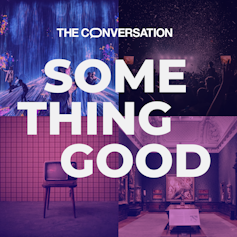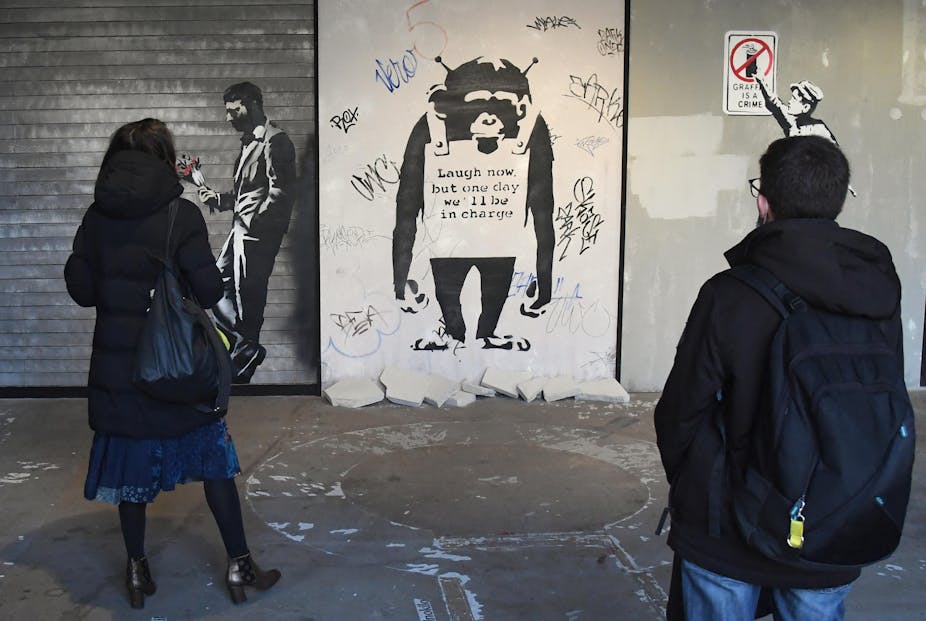The graffiti artist known as Banksy might be unmasked in an upcoming defamation case over his use of Instagram to invite shoplifters to go to a Guess store because it had used his imagery without permission. The case could be seen as an attempt to force Banksy to relinquish his anonymity, which, many say, has been important to his success over the years.
There has been much speculation as to the identity of the artist and he is believed by many to be Bristol’s Robin Gunningham, who was named as a co-defendant in the defamation suit. While it has not been confirmed that Banksy is Gunningham, pointing this out is in no way a revelation. Moreover, trying to find out Banksy’s identity ultimately does not matter.
There have been many investigations into the artist’s identity and it has been the topic of serious journalistic and academic investigation for years, but no one has been able to absolutely link Gunningham and Banksy.
Short of Gunningham’s admission, complete certainty is unlikely. But if Banksy’s identity is revealed, police forces around the world could bring vandalism, property destruction, criminal mischief or worse charges against the individual.
Gunningham revealing himself would also destroy the Banksy mystique.
He is not likely to snitch on himself or damage the brand. The more important reason Gunningham being Banksy doesn’t matter is because there is no Banksy – no individual who is Banksy anyway.
A collective
At one time, there was one Banksy who had a graffiti career and a famous “beef” in the subculture with London graffiti legend Robbo. That time is gone.
Banksy is now a collective of artists who work together to produce thoughtful, provocative and subversive pieces and installations. The scope and secrecy of Banksy’s larger works require the cooperation of many individuals to orchestrate, direct and produce them. The “bemusement park” Dismaland(a sinister take on Disneyland-style theme parks), the Walled Off Hotel (Banksy’s hotel and commentary on the Israel/Palestine conflict) in Palestine and Better Out Than In (Banksy’s New York-wide art residence) are examples of this.
Investigators believe that the collective includes many well-known and established artists. Bristol street artist John D’oh is among those rumoured to be involved, as is graffiti and street artist James AME72 Ame and perhaps even Massive Attack singer Robert Del Naja, among others. This is speculation. And again, this doesn’t matter.
What matters is why Banksy has been in the courts recently. More important than the current defamation suit is the 2021 rejection of Banksy’s trademark by the EU. This was the result of Banksy’s battle with street art greeting card producer Full Colour Black, who used Banksy’s image of a Monkey wearing a placard without permission. The ruling uses Banksy’s own words in the decision, stating:
The ruling notes that the street artist explicitly stated that the public is morally and legally free to reproduce, amend and otherwise use any copyright works forced upon them by third parties.
Also, “copyright is for losers”, as Banksy said in his own 2017 book, Wall and Piece.
The application to declare the trademark invalid was filed in 2018. Banksy took great umbrage at this. In October of 2019, he officially revealed the “homewares” brand Gross Domestic Product. The store is officially the website, but it debuted as a pop-up shop which couldn’t be entered.
A statement posted on the pop-up “storefront” declared that Gross Domestic Product was opened in direct response to the trademark cancellation filing and that selling Banksy “branded merchandise” was the best way to ensure ownership and control of the Banksy name. What’s important here is the clear interest in wanting to maintain control over what is and is not a Banksy and what Banksy artwork is associated with in commercial spaces.

A team of professionals
Banksy fakes are everywhere. The artist’s popularity and the fact that the bulk of Banksy’s work is stencils – which are easily reproduced by anyone with some talent, time and an Exacto knife – ensure fakes and copies will continue to be made. To combat this, Banksy has a cohort of trusted art dealers for official Banskys and an authentication service called Pest Control that chases and legitimates the provenance of Banskys.
While it is entirely legitimate for any artist to want to maintain their unique identity and control over their artwork, it’s rare for an artist to maintain an entire staffed department dedicated to it. Not that graffiti writers don’t defend their copyrights.
Revok, Futura and Rime (to name a few) have defended their ownership of their graffiti and art in court. They hired lawyers, but they didn’t have a division dedicated to preempting and preventing infringement.
Pest Control is seemingly in place to maintain the authentic and unique perspective of Banksy’s works and to confirm they were officially produced by Banksy. This is a process often referred to as brand maintenance.
So, what’s the point of all this? Well, Banksy was an individual street artist at one point. This was probably Robin Gunningham. However, Banksy is now a collective of artists who work under the Banksy brand to produce the works that the Banksy authentication service, Pest Control, officially decrees as Banksys. Banksy is also a team of lawyers, art dealers and curators who ensure that only works officially associated with the Banksy brand get the certified Banksy seal of approval.
None of this is secret, but it’s not been publicised because being a litigious art collective equally as dedicated to producing art as engaging in brand maintenance doesn’t evoke the solo, clandestine, provocative raconteur image Banksy is going for. Having a team of lawyers making sure only real Banksys are labelled as such doesn’t do much for your street cred. Still, revealing this publicly likely won’t diminish interest in Banksy or affect the price people are willing to pay for monkey stencils or self-destroying art.

Looking for something good? Cut through the noise with a carefully curated selection of the latest releases, live events and exhibitions, straight to your inbox every fortnight, on Fridays. Sign up here.


